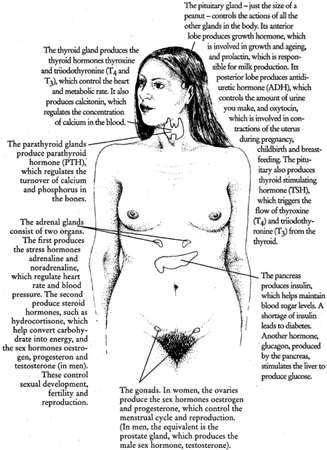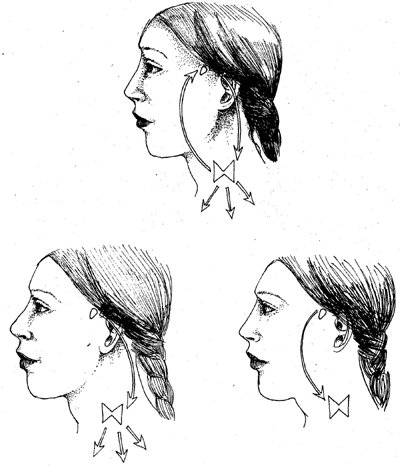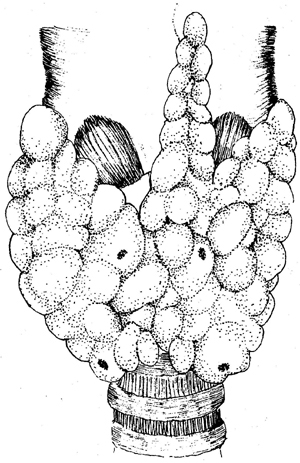
Полная версия
The Healthy Thyroid: What you can do to prevent and alleviate thyroid imbalance
The more you know about the way your body works, the better able you will be to help yourself if something goes wrong. The objective of this book is to provide the information you need to help yourself, to work with your doctor to get the best treatment for your problems, and to feel more in control of your body and your life – something that women with thyroid problems often feel they have lost.
This book does not intend to tell you what to do or replace medical advice. There is a great deal of controversy surrounding thyroid problems – how they come about and how they should be dealt with. The main areas of debate have been outlined in this volume to give you an idea of what different experts think so that you can make up your own mind about how to live with your thyroid problems.
CHAPTER TWO Understanding Thyroid Problems
To better understand what can go wrong with your thyroid, it is necessary to know something about how the gland works. This chapter attempts to reveal why we have a thyroid gland, and looks at the way the thyroid interacts with other systems of the body, including the immune system.
The thyroid is one of 10 glands that make up the endocrine (hormonal) system. From the moment we are conceived until the time of our death, our bodies are under the influence of a cocktail of hormones produced by this system. As this system is so finely tuned, when anything happens to disturb its delicate balance, the repercussions ricochet throughout the rest of the body.
The hormones produced by glands are chemical messengers that are carried around the bloodstream to act on cells and tissues that are often far from their site of origin. Their job is to ensure that we have the correct concentrations of metabolites – vital nutrients (such as sugars and fats), vitamins and minerals (such as calcium, sodium, potassium and iodine), enzymes and other factors essential to life – in the bloodstream.
Each gland has a specific function, but also works with the other glands to keep our body in a state of chemical balance (homoeostasis). One recent, exciting discovery is that not only do hormones interact with each other, but they also exchange messages with other chemicals produced by the brain and nervous system. Research is beginning to uncover more and more links between these major interacting systems, and to throw more light on the way hormones and chemicals produced by the nervous and immune systems work together. This, in turn, is helping to clarify the connection between mind and body as reflected by a diverse number of conditions, including thyroid disease.
Key Sites
The glands themselves are situated at key locations throughout the body (see Figure 2.1). Together they produce over 50 different hormones – so-called ‘mighty molecules’ – that have widespread effects on us from cradle to grave. As hormones cannot be stored in large quantities in the glands, the brain programmes their manufacture by means of a complex biochemical cycle that uses a series of checks and balances to ensure that hormone levels are maintained according to your body’s needs.
In addition to the endocrine glands themselves, other organs contain pockets of glandular tissue that produce hormones. One of these is the hypothalamus, a region of the brain that is both part of the nervous system and a gland.
Not surprisingly, with such a complicated system, things can go wrong. Broadly speaking, when a gland ceases to function as it should, it results in two categories of problems: the gland becomes underactive and produces too few hormones; or it becomes overactive and produces too many.
Balancing the Body
The whole endocrine system is controlled by a series of ‘feedback loops’, which slow or stop a gland from working when enough hormone has been produced, and turn it back on again when more is needed – like a central-heating thermostat (see Figure 2.2). If the blood levels of any of the essential chemicals are low, special sensory cells are able to pick up a signal that

Fig 2.1 The endocrine system

Figure 2.2 The pituitary gland and the hypothalamus in the brain work together to produce a hormone that stimulates the thyroid. The thyroid gland draws iodine from the blood in order to make T3 and T4. Sensors in the TSH-secreting cells of the pituitary detect rising levels of thyroid hormones and quell further secretion. When levels fall, the pituitary releases more TSH, which stimulates the thyroid to start making more hormones.
prompts them to release hormone. This hormone, in turn, acts on other cells to release more of the needed chemical into the bloodstream. When enough chemical has been produced, the sensory cells switch the system off, which stops further hormone release. In this way, the body’s chemical balance is constantly maintained.
The system is exquisitely sensitive: food, exercise, stress, illness, changes in body chemistry such as a shortage or excess of certain nutrients, pregnancy, ageing, even the time of day or year, can affect the balancing mechanism and, with it, the amount of hormones our glands secrete.
Most hormones act only on specific tissues and not all the cells in the body. They do this by latching on to structures called ‘receptors’, which lie studded about the surface of or within cells, rather like a key fits into a lock. This enables hormones to be transported around the bloodstream to specific locations. Receptors are also important because, as we shall see, if the wrong chemical – such as an autoimmune antibody – attaches itself to a receptor, like a thief using a master key to get into your house, it can cause havoc and destruction.
The Thyroid Gland
The thyroid is a small, soft, butterfly-shaped gland that weighs just 15–20 g (1/2–3/4 oz) and is about the size of a plum, yet it is also the largest pure endocrine gland in the body. It lies across the front of the windpipe (trachea) just below the larynx, or voice box (see Figure 2.3). Its two lobes, or sections, lie on either side of the Adam’s apple and are joined together by a narrow bridge of tissue called the isthmus.
You may just be able to detect its outline if you look in the mirror and stretch your neck. If you take a sip of water and swallow, you may be able to see it moving up and down. If you can’t see it, you may be able to feel it with your fingers. (But don’t worry if you can’t see or feel it – not everyone can.)
The thyroid develops in the womb during the first weeks of life from a small piece of tissue at the root of the tongue. As the fetus grows, the tissue moves down the neck to rest at its adult position. By the time the fetus is just 12 weeks old, the thyroid has already started to work.
The thyroid is made up of two types of hormone-secreting tissue: follicular cells and parafollicular cells. The follicular cells, which make up the greater part of the thyroid, are hollow spheres surrounded by tiny capillary blood vessels, lymphatic vessels and soft connective tissue. Each follicle is filled with a yellow, semifluid, protein-containing material called thyroglobulin (TG) which, when broken down, interacts with

Figure 2.3 The thyroid gland lies across the windpipe in the throat.
iodine stored in the thyroid to produce thyroid hormone (TH). The parafollicular cells lie on their own or in small clusters in the spaces between the follicles and secrete another hormone – calcitonin.
A Tale of Two Hormones
The thyroid’s main purpose is the production, storage and release of thyroid hormone. Although referred as a single entity, there are, in fact, two thyroid hormones: thyroxine (T4) and triiodothyronine (T3), which carry four and three atoms of iodine, respectively.
T3 is four times more potent than T4 and works eight times more quickly. Yet, T4 is about 50 times more abundant in the bloodstream than T3. This is because, although small amounts of T4 are converted to T3 within the thyroid gland itself, most T3 is produced outside of the thyroid by a process called monodeiodination, which strips away one of the iodine atoms from T4. This allows the body to produce T3 as needed – like changing your five-pound notes into one-pound coins for the parking meter.
All Under Control
Like all of the glands in the body, the thyroid is regulated and controlled by the pituitary gland, the small, pea-sized gland attached to the brain often referred to as the ‘master gland’. The pituitary gland orchestrates the entire hormonal symphony but is, in turn, driven by the hypothalamus, to which it is joined by a short stalk of nerve fibres. This hypothalamic – pituitary – thyroid gland connection is a key junction through which chemical messages are carried to and from the brain and the body.
Levels of thyroid hormone are regulated by a feedback loop that operates between the hypothalamus, pituitary and thyroid glands. Anything that increases the body’s need for energy – such as a fall in temperature or a bout of exercise – will provoke the hypothalamus to secrete a chemical messenger called thyrotropin-releasing hormone (TRH) to trigger the pituitary to secrete a messenger chemical called thyrotropin or thyroid-stimulating hormone (TSH), which stimulates the thyroid to secrete thyroid hormone. As the thyroid releases increasing amounts of TH, chemical messages are eventually passed on to the hypothalamus to inhibit production of TRH and, in turn, TSH.
This chemical round-robin means that TSH levels are a highly sensitive indicator of thyroid activity and can provide an early clue that the thyroid is not working as it should. This is why the TSH test is a key investigation in checking the health of your thyroid (see Chapter 4).
The Calcium Connection
The thyroid is crucial in maintaining the strength and density of our bones. The parafollicular cells of the thyroid produce the hormone calcitonin, which is involved in regulating calcium levels in the body. As well as being the main mineral used for making bone, calcium is needed to trigger impulses in nerve and muscle cells.
Calcitonin acts with another hormone – parathyroid hormone (PTH) – produced by the parathyroid glands, four tiny glands that lie behind the thyroid. Whenever calcium is needed, PTH raises the levels of calcium in the blood by stimulating the release of calcium from bone, increasing the reabsorption of calcium from the kidneys and converting vitamin D into a hormone that increases gut absorption of calcium. Once calcium levels have been increased, the thyroid releases calcitonin to suppress the release of calcium from bone.
The Incredible Thyroid
Although the thyroid is only a small gland, the hormone it produces is responsible for an incredible number of biological processes. In fact, it would be fair to say that TH is essential for the health of virtually every cell in your body. Cell growth, muscle strength, body temperature, appetite, cholesterol levels, mood and memory all depend on thyroid hormone. Likewise, your heart, liver, kidneys, reproductive organs, hair and skin all require TH to function properly.
So widespread is the activity of TH that, indeed, in Victorian times, doctors believed the thyroid was vital to life. Although it is possible to live without a thyroid, provided you receive thyroid-hormone replacement therapy, they were not that far from the truth. Thyroid hormone is unique in that, throughout the whole of our lives, it acts within almost every tissue in the body and is vital for general health and wellbeing.
A MATTER OF ENERGY
The main job of thyroid hormone is to regulate your metabolism – the rate of your body’s cell activity. It does this by activating mitochondria, the tiny cellular ‘powerhouses’ that produce energy. The process of metabolism – the word literally means ‘change’ – among other things, controls your appetite and maintains your body temperature, whatever the external environment.
Your metabolism determines the rate at which your cells burn oxygen, a process involved in every activity of life – from breathing and sleeping to eating, talking and moving around – as well as all the activities of your internal organs, such as the beating of your heart, the digesting of your food, the functioning of your reproductive organs and, most important of all, the working of your brain.
A LIFETIME OF ACTIVITY
Thyroid hormone is active when the embryo is still in the womb, where it plays a crucial part in helping each of the millions of cells in our bodies to become more specialized. It is this process, known as differentiation, that turns tadpoles into frogs and a human embryo to develop from a tiny cluster of cells into a fully grown baby.
At the other end of life, the thyroid is thought to play an equally important role in the control of ageing.
THE GROWTH FACTOR
In the womb and after birth, thyroid hormone is vital for both mental and physical growth. With somatotrophin (STH) from the pituitary, it determines the length and strength of your bones. During childhood, lack of TH stunts growth by preventing the bones from growing and maturing. TH is also crucial for the normal development of the brain and nervous system in both the unborn and newly born infant. During pregnancy, low levels of T4 can affect brain development, resulting in mild-to-severe mental deficiencies. In the past, the term used to describe these defects was ‘mental cretinism’.
BREAST DEVELOPMENT
Thyroid hormone may also be involved in the development of our breasts. Studies in mice have shown that TH affects prolactin, another pituitary hormone. In breastfeeding women, this hormone is involved in stimulating the production of milk. It is also thought that breast pain that is not premenstrual breast tenderness and swelling may be linked to thyroid problems.
PROTECTION AGAINST STARVATION
When it works properly, the thyroid plays a crucial part in keeping your body weight more or less stable. Increasing the amount you eat, especially of starchy foods or carbohydrates, increases metabolism and boosts the production of the active thyroid hormone T3. Dieting, on the other hand, decreases metabolism, causing the body to produce less T3.
This is almost certainly a mechanism that has evolved to protect us from starvation. It is a known fact that when the body is deprived of food, it turns down the rate of metabolism. This is one of the mechanisms thought to have enabled the survival of the babies who, incredibly, were found still alive after several days trapped under the rubble of the Mexican earthquake in the 1980s. This same mechanism also explains why the thyroid becomes sluggish in women with eating disorders such as anorexia, bulimia and excessive dieting. The brain correctly perceives these states as starvation and turns down thyroid activity to conserve energy. This is how a thyroid problem can play havoc with your appetite and your weight.
PROTECTION AGAINST INFECTION
The thyroid is a vital part of the body’s immune-defence mechanism. It stimulates the production of special white blood cells, known as T cells and B cells, to help the body fight against disease. Chronic liver and kidney disease, acute and chronic illness, starvation and diets too low in carbohydrate lower the production of T3. It is thought that this may be part of an adaptive process to help the body defend itself against illness.
FLUID BALANCE
The thyroid plays a vital role in a myriad other bodily processes. It helps to maintain the body’s fluid balance by controlling the mechanisms by which water and chemicals enter and leave the cells – one reason why bloating is troublesome if you have an underactive thyroid.
VITAMIN POWER
In the liver, thyroid hormones are needed to convert beta-carotene (the pigment that gives orange, yellow and red fruits and vegetables their colour) into vitamin A. In the past few years, beta-carotene has sparked considerable interest as one of the three key antioxidant vitamins (the other two are vitamins C and E) that play a crucial role in protecting the body against degenerative diseases, such as cancer and heart disease, and those associated with ageing.
INTERACTIONS WITH OTHER HORMONES
Thyroid hormone needs to be present for other hormones to function in various parts of the body. Most important for women, it acts in concert with the female sex hormone oestrogen to modulate reproduction. This is why thyroid malfunction can sometimes be a cause of reduced fertility and other reproductive problems.
Manufacturing Thyroid Hormone
The mineral iodine – a trace element found in soil and food – plays a central role in the manufacture of thyroid hormone. Iodine is needed for cells to work properly. To produce hormone, the thyroid absorbs iodine and, through a process involving enzymes, combines it with the amino acid tyrosine. More enzyme reactions convert this into T4 and T3, which are then stored by the thyroid within a protein called thyroglobulin (TG). When thyroid hormone is then needed in the body, enzymes break down this TG to release the T4 and T3 into the bloodstream.
Transporting Thyroid Hormone
Most of the thyroid hormone in the body is carried around the bloodstream attached to special transport proteins, especially thyroid-binding globulin (TBG). Once the bound thyroid hormone reaches its destination, it is released from the protein binding so that T4 can be converted to T3 and ready for use by the cells. A tiny amount – around 0.03 per cent of T4 and 0.3 per cent of T3 – remains unattached to float freely about in the blood. Although only a small quantity, free-floating T3 does not have to be released from any binding and so is immediately available for use by the cells.
Certain conditions, such as taking the Pill, can raise the levels of protein in the blood and, in the past, thyroid tests which measured total levels of T4 and T3 were not always accurate because of some confusion in interpreting results. Today’s blood tests measure levels of both free-floating T4 and bound T4 as well as thyroid-stimulating hormone, which provide a much more accurate indication of thyroid function.
What Can Go Wrong?
The most common thing to go wrong with the thyroid is autoimmune thyroid disease, when the body turns against its own tissues and tries to destroy them. Over a period of time, this causes the thyroid to become either overactive (hyperthyroidism) or underactive (hypothyroidism). The result is Graves’ disease, the most common form of hyperthyroidism, and thyroiditis, the most common form of hypothyroidism.
But why should a mechanism designed to protect our body and keep it healthy go so drastically wrong? To find the answer, it is necessary to delve deeper into the fascinating science of immunology.
Immune Reactions
The body’s defence system normally provides a formidable barrier against attack by ‘foreign’ invaders such as viruses, bacteria and parasites. Although the way it works is still not fully understood, what is known is that many actions depend on two kinds of lymphocytes (white blood cells) – T cells and B cells – responsible for fending off attackers from outside.
When the body is under attack by invaders, the immune system sends T cells to the affected site to find out what is happening. There are two types of T cells: helper cells and killer cells. Helper cells help the immune system by identifying antigens, a chemical substance that marks the invaders as ‘foreign’. Once the helper cells have recognized a foreign antigen, killer cells are despatched to attack and destroy them. To protect the body against future attack by the same foreign invaders, killer T cells retain a ‘memory’ of their antigen. If the body is threatened again by the same invader, these killer T cells are quickly activated and sent in for the kill. This entire process is known as cellular immunity.
B cells work in a similar way except that they fight off an attack by producing protein antibodies known as immunoglobulins; these are produced specific to the invader. When the immune system identifies a particular invader, B cells are stimulated to produce a large quantity of a specific immunoglobulin that will attach itself to the invading antigens and immobilize them. Once this has happened, the antigens are devoured by other white cells called phagocytes. This process is known as humoral immunity.
The Enemy Within
Under normal circumstances, the immune system does not turn against itself because our own cells are coded to allow our T cells and B cells to recognize them as ‘self and refrain from attacking them. Scientists still do not know exactly why this normal recognition process fails. One theory is that, in some cases, a foreign antigen – say, a protein on a virus – escapes the immune system’s surveillance by disguising itself as one the body’s own cells. As the immune system cannot distinguish this disguised protein from its own tissue, it allows the invader access to the cells.
Inflammation From Within
Another way in which the immune system can go awry is when an invader triggers an overzealous immune response, unleashing a flood of cell proteins called cytokines; these cause inflammation and increase the production of antibodies, which turn against the tissue in question and destroy it.
Both Graves’ disease and Hashimoto’s thyroiditis are caused by T and B cells that infiltrate the thyroid, triggering inflammation and the production of thyroid autoantibodies. Depending on which autoantibodies are produced, this will lead to either overproduction or underproduction of thyroid hormone.
Autoantibodies can attack virtually any of the body’s tissues or organs and not just the thyroid, causing a range of diseases in which the tissues become inflamed and are gradually destroyed. These include rheumatoid arthritis, where autoantibodies destroy the joints; Addison’s disease, where autoantibodies damage the adrenals; multiple sclerosis, where autoantibodies are directed against the nervous system; and diabetes, where autoantibodies turn against the pancreas.
It is now established that all of us possess autoimmunity to some degree but, in some people, the immune system seems to have a particular tendency to turn against itself. This might explain why having one autoimmune disorder can put you at an increased risk of developing another. It may also be why, if you have developed an autoimmune thyroid disorder, it is important to be on the look-out for other autoimmune problems.


